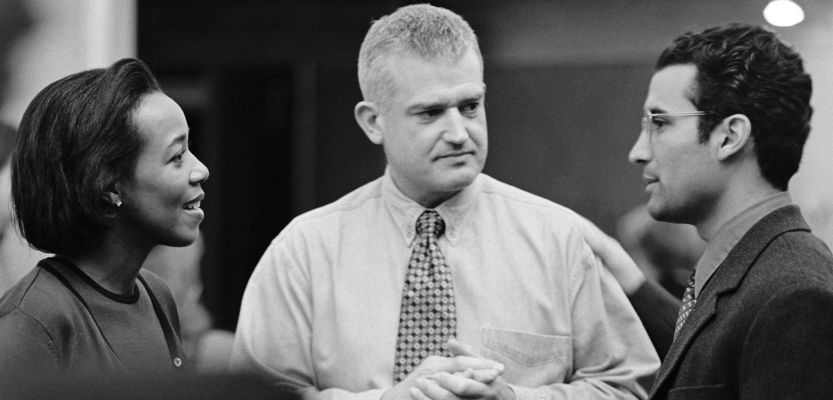Talk about your business – how to present yourself with impact
‘What do you do?’ It sounds the most innocuous question but it can be the hardest one to answer clearly, concisely and with impact. Does that matter? Yes, if you want people to understand, connect with and remember you after your conversation. In this blog, I’ll share with you the three key elements that need to be included in your answer when you talk about your business.

Here are some recent experiences
Three instances prompted this blog. They demonstrate why we need to be able to talk about the business or project or passion clearly, concisely and in a way that connects with the audience.
Networking
I once sat next to someone at a networking breakfast. The group were doing short 60 second introductions and it was their turn. They ran over their time. They repeated themselves. And no one was any the wiser! Approaching them afterwards, I apologised and said that I hadn’t quite caught what it was that they did. They embarked on another (lengthier) explanation at the end of which I still didn’t understand.
This failure to talk about your business, what we do (or our organisations do) in a way that other people understand is a problem if you rely on networking, collaboration or referrals for growth or progression. How can people talk about you behind your back (my rough and ready definition of networking btw) or recommend you or even buy or use your services if they can’t grasp what it is that you do?
It is also a problem if we are addressing our team, partners, project collaborators. Lack of clarity will lead to problems further down the line.
It’s not what you do…it’s the impact you make
I ran a workshop on presentations skills and was thrilled when a delegate declared he’d had a Light Bulb moment. He explained that he was a bridge builder. In fact he loved building bridges. He loved talking about building bridges. When he was presenting in his professional capacity, though he’d just realised something profound. Most of his audience were not as interested in him about talking about bridges. They were more curious and excited about how those bridges gave them access, freedom, and connection with other parts of the town. Which raises the question about what you focus on when you talk about your business and organisations and how much your audiences need to hear what you have to say.
A download of data
Finally, I remember several presentations where I’ve found my mind wandering after the third or fourth slide showing me the timeline of an organisation, the organigram with the names of every employee on there in minuscule writing and a copy of the vision and mission statement taken from the annual report. This is a download of data, not a presentation. It isn’t answering the question, ‘What do we do?’ and it certainly doesn’t get the pulse racing or even an eyebrow raising.
Why?
Because it fails to answer the two fundamental questions every audience needs satisfying –
So what? and
What’s in it for me?
When we know that it is relevant (so what?) and we can anticipate the value to us of what’s being said (What’s in It for me?) then the content is more meaningful and memorable. Oh, and relying on slides to do the job for us but not designing those slides well, doesn’t help but that’s the subject of another blog – take a look here.
Three challenges
Each of these situations highlight three challenges you face if you talk about your business in public. How do we:
- speak so people ‘get’ what we are saying (as concisely as possible)?
- make sure we talk about things the audience need to hear (as opposed to our pet project)?
- make sure that we are relevant and valuable in our content?

Four keys to talk about your business effectively
- START WITH THEM: Start talking about your customer/client first before you talk about you. In some cases that is the audience. Show that you understand the world they live in and that you have empathy with the context in which they operate and live. When we do that, we show our credibility, we build rapport, and we incite curiosity.
- IMPACT HAS MORE IMPACT: Recognise that most times, people are far more interested in the impact of what you do rather than what you do. I may be vaguely interested that you are an accountant, but I am more interested in the fact you can help me control my finances and taxes and relieve some of the pressure of bookkeeping. I am interested in your bridge but more interested in what that bridge does for my community.
- ANSWER THE ‘SO WHAT?’: Make sure that your talk is relevant for that particular and present audience. Do this before you focus on the benefits of your product or service. If it is not relevant, I won’t listen to the rest of it anyway.
- IT’S NOT ABOUT YOU: we often start preparing a talk by thinking about what we want to tell the audience but a more effective approach is to think about what the audience need to hear.
Start a conversation
Clarity, understanding and action don’t just happen. They are not the result of downloading irrelevant information in a haphazard way to our audiences. It is worth thinking about and crafting an answer to that question, ‘What do you do?’ because it could be the start of a conversation which leads to connection which leads to relationships.
If you need to talk about your business and need some help, let’s chat – get in touch.